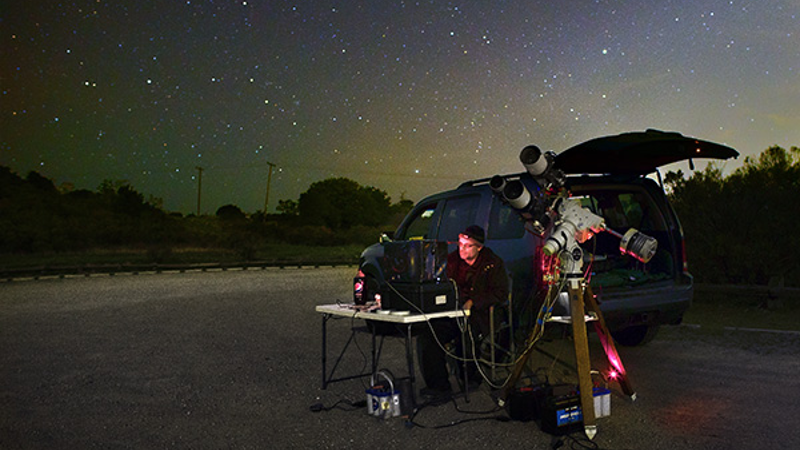Love it or loathe it, launching a sports car into space is a hell of a spectacle, and did a great job at focusing the spotlight on the Falcon Heavy spacecraft. This led [Rogelio] to wonder – would it be possible to snap a photo of Starman from Earth?
[Rogelio] isn’t new to the astrophotography game, possessing a capable twin-telescope rig with star tracking capabilities and chilled CCDs for reducing noise in low-light conditions. Identifying the location of the Tesla Roadster was made easier thanks to NASA JPL tracking the object and providing ephemeris data.
Imaging the Roadster took some commitment – from [Rogelio]’s chosen shooting location, it would only be visible between 3AM and 5:30AM. Initial attempts were unsuccessful, but after staying up all night, giving up wasn’t an option. A return visit days later was similarly hopeless, and scuppered by cloud cover.
It was only after significant analysis that the problem became clear – when calculating the ephemeris of the object on NASA’s website, [Rogelio] had used the standard coordinates instead of the actual imaging location. This created enough error and meant they were looking at the wrong spot. Thanks to the wide field of view of the telescopes, however, after further analysis – Starman was captured, not just in still, but in video!
[Rogelio]’s work is a great example of practical astronomy, and if you’re keen to get involved, why not consider building your own star tracking rig? Video after the break.
[Thanks to arnonymous for the tip! If that’s a nickname and not just a request to be anonymous but misspelled.]
















He’s just going for the “car with the most miles” bragging rights =o)
Cosmic Rays are hell on tires…
Tesla Roadster, 158 million miles (Aphelion), some sun damage, pick up only.
Micro meteorites also pits the wind shield.
Cocaine is a hell of a drug……
F that UVs will bleach it and brake down almost everything but the metal in a few years
That’s ok, traction in space is pretty crappy anyway. :-) Bleached out disintegrating tires will not reduce their effectiveness. :-) I’d be more concerned about all those Li-Ion batteries. :-)
It would be fascinating to recover this vehicle in a few years and see how it has handled being in space… I’m really curious as to how the various materials it is made from will endure.
Heh, getting it back to Earth orbit probably wouldn’t be too challenging for SpaceX, but getting it back on the ground would be incredibly hard. I do like the mental image of a ‘Skycrane’, like was used to drop Curiosity on Mars, dropping the roadster and it just bouncing on its shocks a little.
Sort of like the Corvette scene from Heavy Metal, with the Riggs playing in the background.
https://www.youtube.com/watch?v=t_KXgFpguE0
Almost 300,000 views as of right now, probably most recently. I can’t possibly imagine why. ;-)
One wonders if the Loc Nar is in the trunk.
Important safety tip: stay away from the Loc Nar
Unless you’re Den.. It seemed like he came out on the plus side.
Between radiation, vacuum, and constant heating/cooling cycles, there won’t be much left of it inside of a year. Pretty much all of the organic components, including the carbon-fiber portions, will vaporize. http://www.newsweek.com/elon-musk-tesla-spacex-falcon-heavy-disintegrate-800610
I wonder if lithium batteries will ignite in space, being a vacuum and all, but the rapid reaction between the components of a battery would be enough to create a combustion I imagine right? In which case it would also create a small propulsion effect if it happened in space.
Now the question is how many batteries did they leave in for that MP3 player, and how soon will there be a runoff reaction if at all? Or is the player powered by the batteries of the propulsion sled and doesn’t the car have any batteries?
And if it has batteries and they do ignite and they do propel, will they push it into a collision orbit?
“… is a hell of a spectacle, and did a great job at burying the news of Teslas biggest quarterly loss ever.” :P
But they did not once again do a recalculate on when they finally have production running at speed, after previous delays and snags. So they are optimistic they will now definitely get on track (or sled if you prefer) as they predicted earlier.
And the production run of flamethrowers went OK :)
I wonder what is this thing at the bottom right that jumps :)
Not to be super-pedantic, but the Falcon Heavy isn’t a spacecraft. It’s the booster rocket that puts the spacecraft/payload into orbit.
The correct term is “up goer help thing”.
If your vocabulary is limited to ten hundred or so words, you’re correct. I wouldn’t want to brag about that though.
From the video it does look like the car is spinning wildly.
So cool great work….
Without some form of attitude control this is unavoidable…
I didn’t see him signal for the left turn either!
The Ephemeris link points to the planet Mars, not to target object ‘Starman’.
That’s because, shortly after the video was taken, Starman went to warp speed and is already on Mars, sipping mint juleps.
I’m going a bit out on a limb here,
but I think those “two telescopes” are really a pair of binoculars, such as those used by comet spotters.
Space junk, the ultimate quary. Dark, elusive, and well worth finding. Talk about bragging rights. :-)